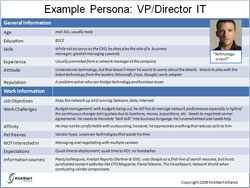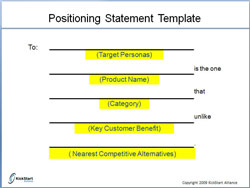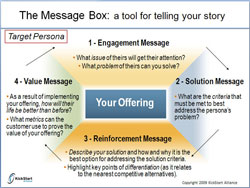
www.kickstartall.com
Personas, Positioning & the Message Box
by
Mike Gospe
When lead generation programs fail, they do so mainly because the messages communicated are irrelevant or ill-timed for the target audience. Our target customers are bombarded with thousands of messages every day. Unfortunately, we (as a society) have become so used to information overload it's become the white noise of the marketplace. As a result, the knee-jerk reaction from companies is the "ready, fire" execution of promotional offers. It's easy for marketers to fall into the trap of believing that volume replaces the need to "aim."
Here's the good news: it's easier than you think to get out of this cycle of noise-producing marketing that feeds the black hole of spam filters everywhere. All it takes a small bit of back-to-basics marketing discipline with three key exercises designed to help you understand the buyer. After all, in our competitive business climate, whoever understands the buyer the best, wins. Hands down.
The key to maximizing ROI of any marketing investment (big or small) is to truly understand buyers, what makes them tick, and the business problems they are trying to solve. The best, most effective lead generation programs always start with an investment in these three disciplined exercises:
- Creating the Persona,
- Tuning the Positioning Statement, and
- Crafting the Story (with customer-friendly messaging)
Here's an example of each and how they build off of each other.
Part
1: The Persona
 Figure 1: an example of a Persona. Click on the image to enlarge. |
Key to each persona is more than just basic demographics. We also want to include information about what they think and how they make purchase decisions. Include notes on their psychographics, work challenges, pain points, and search preferences. To get started, chat with a few sales reps to get their thoughts on how customers behave. You might also interview a few friendly customers to get some direct insights. Persona building is not a one-time static exercise. It's intended to help you shape a hypothesis about a target market sweet spot. As you market to these folks, you'll learn more about them and how they engage with you. Based on feedback and further insight, you'll want to change and adapt the persona over time.
2. The Positioning Statement
 Figure 2: a simple yet thought-provoking template for crafting a focused positioning statement. Click on the image to enlarge. |
While I'm not at liberty to share with you their specific positioning statement created for the above persona, I can tell you the following:
- The few words describing the "persona" in their positioning statement were pulled directly from the persona illustrated in Figure 1.
- The "product name" is literally the product/service the customer ends up buying. This is not intended to be generic or intangible. It's on the price list and has a product number or code associated with it.
- "Category" allows for a lot of creativity. With a nod towards industry trends and the shifting requirements of our target persona, we were able to create a new, logical category where the product is unique.
- Customers realize many "benefits" from the product. However, we focused on the one key benefit we felt was most imperative to our target personas and the problems they are trying to solve. While our messaging will unfold over time to address many benefits, we want our central benefit to be thematic and resonate continuously.
- The "nearest competitive alternative" is where we highlighted a few key points of differentiation.
3. The Message Box
 Figure 3: the "Message Box" template. Simply, the most effective exercise for drafting an "elevator pitch" that tells your story. Click on the image to enlarge. |
In the center of the Message Box is the product being promoted. The "story" is comprised of four messages that build off one another, and they are numbered 1, 2, 3, and 4.
- Message 1 is known as the "engagement message." A hook — usually expressed as a problem or opportunity – designed to literally engage the target audience in a dialog. This statement must be simple, yet relevant and clear.
- Message 2 is the "solution message." This message suggests a criteria that must be met to address the problem or opportunity shown in the engagement message.
- Message 3 is called the "reinforcement message." Now is when we introduce our product by name. Whereas the engagement and solution messages are about the buyer, reinforcement is about our product and how it is the best option for satisfying the conditions stated in the solution message.
- Message 4 is all about "value." Literally, this message is designed to show how life for the customer will be better than before by using the product. It's benefit focused.
When combined, these four key messages create an effective 30 second "elevator pitch." With a solid persona and positioning statement in hand, the Message Box exercise takes about 45 minutes. Of course, this is just the beginning of a messaging strategy. Use the Message Box to create a solid foundation from which to build a full content strategy that will help you map the right messages (and the required content) to each stage of the prospect's buying cycle.
Even Tiger Woods needs his practice
While many of us will recognize a good target market assessment,
positioning statement, and messaging strategy when we see
one, the basic truth is that it is hard to do. Challenge your marketing
team to sharpen their pencils and apply these techniques.
As you plan the next generation of your integrated marketing plans,
take a few minutes to run through each of these exercises and critique
your work. I guarantee that your efforts will be well rewarded
with a better understanding of (and more empathy for) your
target markets, crisper positioning statements, and more relevant
messaging that will successfully cut through all the clutter.
About the Author
Mike
Gospe leads
KickStart Alliance's marketing operations practice where he conducts team-based "practical
application working sessions" to improve the effectiveness of lead generation
campaigns and product launches. His fun, practical approach and roll-up-his-sleeves
attitude energizes teams, helping them to get "real work done" while
guiding them to the next level of excellence. Mike is
the author of the book, Marketing
Campaign Development, and his methodology is being used by San
Francisco State University's College of Extended Learning
course: "Essentials
of Integrated Marketing."
Copyright 2010 KickStart Alliance www.kickstartall.com